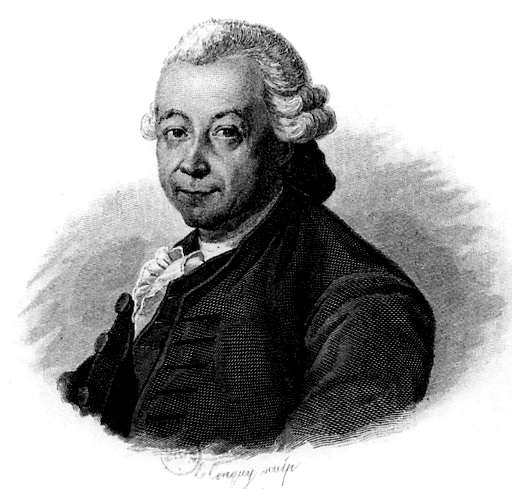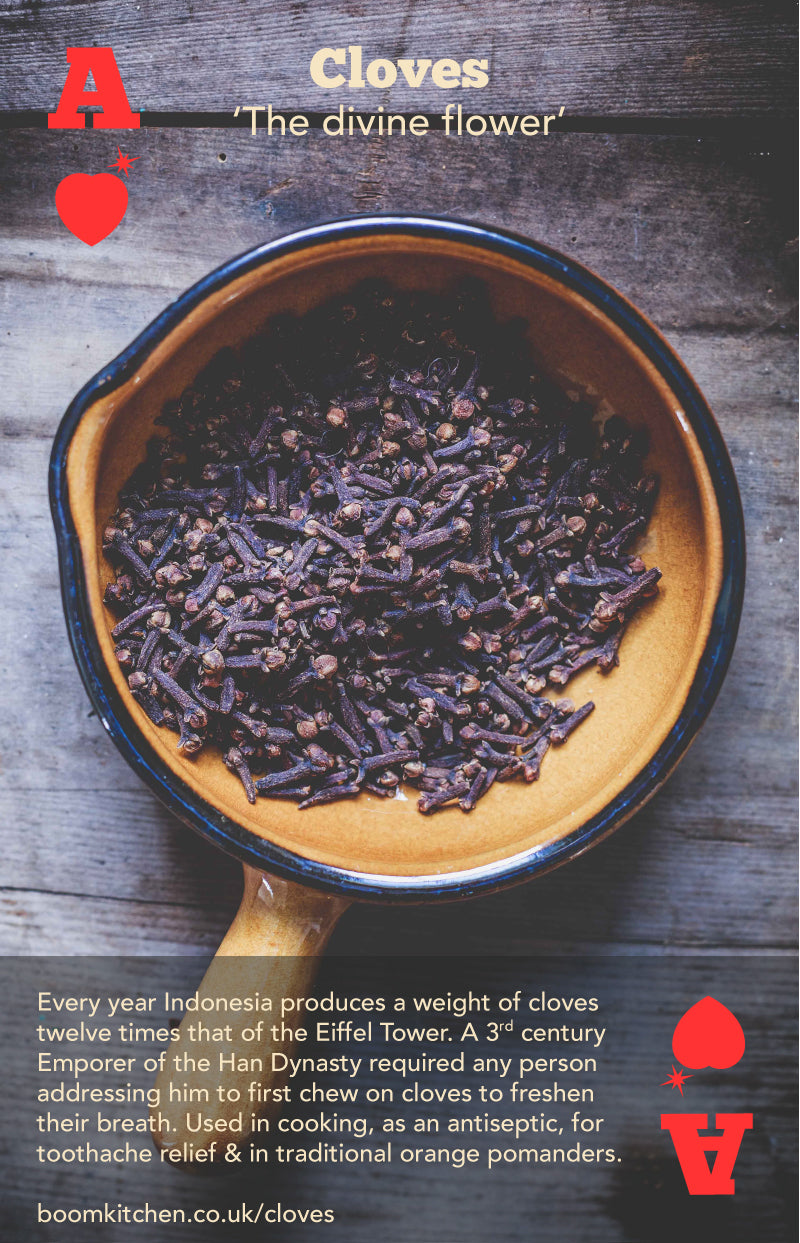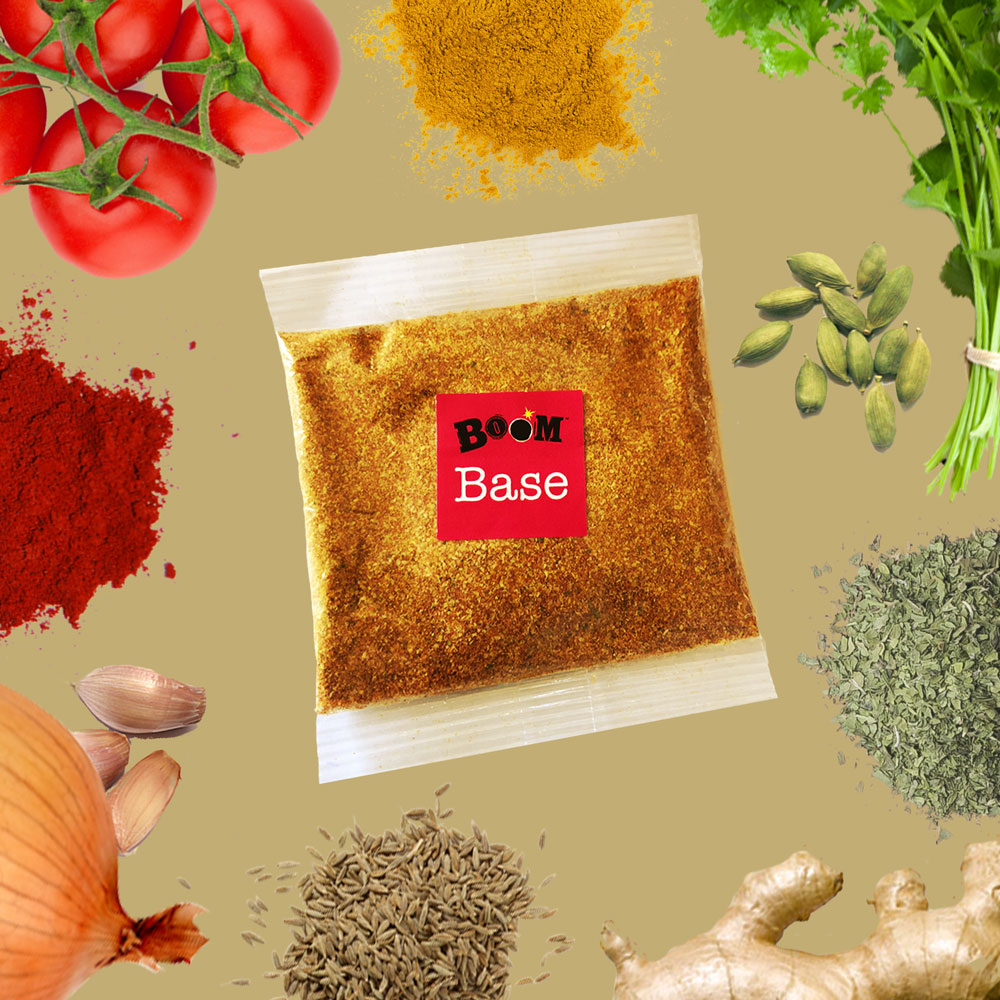Learning about the ingredients and spices that go into our kits can be fun too so we're designing some playing cards to bring them to life. As we compile the stories behind the ingredients we'll add more articles. We'll then squeeze as much info on to the playing cards as space allows. Once the deck is finished we'll be sure to let you know!
Today we're getting started. This article is brought to you by the Ace of Hearts and the letter C.
C is for Cloves
What is the technical name for cloves?
In your best Russell Crow, Gladiator voice, 'Eugenia caryophyllus'.
How much are cloves?
Approximately £28 per kilo based on jar of cloves at a UK supermarket (Sainsbury's 2021).
Grading of cloves
Cloves are processed in three main grades:
- Hand Picked
- Grade 1
- FAQ (Fair to Average Quality)
These 3 grades consider:
- the levels of headless cloves
- cloves below 10 mm lengths
- fermented cloves
- extraneous matters
Handpicked cloves are the Superior grade. This grade contains good size full bud Cloves with beautiful colour and excludes cloves without heads or stems. Colour is also determined by whether the cloves are machine or sun-dried. Machine dried cloves are lighter in colour and more desirable.
Grade 1 is the second best. This grade is mostly consisted of full bud cloves with small percentage of headless cloves.
Cloves FAQ is a mixture of full bud cloves, headless cloves and stems.
What are cloves?
Cloves are dried, unopened, flower buds from a tree native to the Maluku Islands in Indonesia.

Image source Bicho_raro
The clove tree is an evergreen, Syzygium aromaticum, which is part of the the Myrtaceae tree family.
Jamie Oliver takes time out of a busy shoot to film this decent tribute to the clove. He ends his piece to camera with a call to arms, urging us all to marinade our thruppenny bits in clove infused bathwater. You may think such a bourgeoisie suggestion is indicative of Jamie losing touch with reality. Two fingers up to the people who helped put him where is is today. However, we believe Jamie's onto something. What would once have been a luxury only afforded by frilly blouse wearing French Aristocrats is now within all our reach. Cloves boast antiseptic qualities, give off a sweet scent and are affordable, making them an excellent choice for spicing up bath times. Why not give it a go next time you run out of Himalayan salts.
The journey of a clove, from tree-top to spice rack and, if it's really lucky, a Boom curry kit
1. Mature clove trees are typically around 15m (50ft) high so pickers need to be nifty climbers to harvest the unopened flower buds from the higher branches.

Image Source Natasha von Geldern
2. The clove leaves are separated from the buds.

Image source - the above image and clove harvesting images below are from the BBC.
3. Both the clove buds and the leaves are laid out on mats to dry in the sun for around 3 days. As they dry they release a sweet, heady aroma. Is it bath time yet?
The leaves often make their way into perfumes and fragrances. Clove oil can also be extracted from the leaves for sanitary applications, dentistry products and general hipster wares.

4. The clove buds are sifted to remove dirt and bugs.

5. Buds are then taken to markets where they are spread out and graded by quality, size and for some premium retailers by gender pro-noun.

6. Pay day for the farmer. Cloves are sold in 90kg sacks, that's just over one Paul Pogba and, some would unfairly argue, about as mobile. A farmer can expect £520 ($720) a sack which Paul can earn just looking for his Air Pods.

If the farmer could fetch the 28p per gram Sainsbury's do they could earn £2,520 per sack. Hopefully, through the miracle of the blockchain farmers will get there soon.

Which country produces the most cloves?
Indonesia is the largest producer of cloves churning out a massive 123,399 metric tonnes in 2018. That's equivalent to Indoneisa producing nearly 12 times the weight of the Eiffel Tower in cloves.
In 2018 Indonesia produced nearly three quarters (73.7%) of the world's cloves. The other largest producers include Madagascar, Zanzibar, India, and Sri Lanka.
Cloves are natural breath fresheners
Legend has it that a Chinese Emperor of the Han Dynasty (200 B.C.) demanded those who addressed him to chew cloves before to freshen their breath.
History of the clove
Pepper, clove, and nutmeg - were the original holy trinity of the Asian spice trade.
Evidence of cloves being used has been found as early as 300 B.C. in the ancient city of Terqa on the banks of the Euphrates, now Syria.
Cloves were one of the rarest and most expensive spices in the Roman empire and were traded as early as the first century AD. We know this because Pliny the Elder, Ancient Rome's answer to David Attenborough wrote about them. 
Image Pliny the Elder source Brittanica.com
Pliny the Elder also has a craft beer dedicated to him. We'll be sure to try and get our hands on some and wash down one of Boom Kithen's 'cloveier' curries.

Image source theefullpint.com
By 176 AD, cloves had reached Egypt. Later, c.800 AD ancient texts from India refer to cloves as the ‘divine flower’ and associate them with the Hindu goddess Lakshmi who symbolised beauty, wealth and fortune.
Their source remained a carefully guarded secret until 1512, when the first Portuguese explorers set foot on the Maluku Islands (also known as the spice islands).
Intense fighting followed between the Portuguese and Spanish for control of the lucrative plant. Forts were erected and destroyed, but ultimately the Dutch gained control of the Maluku Islands, the only place known to have clove trees. The Dutch East India Company (DEIC) would go on to control the islands and a clove monopoly for the second half of the 17th century and most of the 18th.
The Duch clove racket
The Dutch were the Joe Pescis of the early spice trade, running a textbook mafia-style clove and nutmeg racket. In order to keep prices high they restricted the amount of spices that could be exported each year, destroying any surplus to prevent a black market emerging.
In 1772, during a DEIC banquet ball with distinguished guests in attendance, DEIC soldiers torched a pile of spices reported to be 100 feet long, 25 feet wide and 15 feet high. That's 37,500 cubic feet of spices, equivalent to 912 tonnes or six times the weight of the Statue of Liberty.
Another company policy enacted by the DEIC was to uproot or eliminate all clove trees not under their control. This policy was carried out but it seems they missed a tree.
The mother tree that felled a monopoly
On the side of a remote mountain, the Afo Clove Tree went undetected and survived the Dutch cull. In 1770, a French missionary, aptly named Pierre Poivre (Peter Pepper), stumbled upon the hidden tree, and smuggled some of its precious seeds out to the French colonies.

Pierre Poivre – French missionary and spice smuggling bad ass.
Image source The Treeographer
Poivre successfully used Afo’s contraband to propergate new clove plantations in the French Seychelles and Zanzibar. A pocketful of seeds had proved enough to end the Dutch clove monopoly.
As for Afo, it stayed put (as trees tend to) on the slopes of Mount Gamalama and grew to be nearly 400 years old, and more than 40 meters tall.
It lived to see the soil around its roots exchange hands between the Portuguese, Spanish, Dutch, and later the Japanese during World War 2. Ironic and fitting perhaps that it was a local that brought Afo down. Hacking away at it for firewood some time in 2014. While its branches are gone its story lives on. Today a small brick walls protect Afo, a symbol of the import role the Maluku Islands played in world history.

The remains of Afo.
Image source The Treeographer

